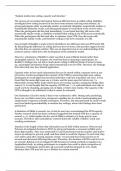“Explain studies into coding, capacity and duration.”
The process of converting information between different forms is called coding. Baddeley
investigated how coding occurred in the short term memory and long term memory, by
giving participants either acoustically similar, acoustically dissimilar, semantically similar or
semantically dissimilar words, and asking participants to recall them in the correct order.
When the participants did this task immediately, it was found that they did worse with
acoustically similar words, so Baddely concluded that coding in the STM occurs acoustically.
When the participants did this task after 20 minutes, from LTM, they did worse with
semantically similar words, and therefore coding is said to be semantic in LTM.
One strength of Baddley’s study is that it identified a key difference between STM and LTM.
By illustrating the difference in coding between the two stores, this provides support for the
idea that they are separate entities. This was an important step in our understanding of the
memory system, which led to the development of the multistore model.
However, a limitation of Baddley’s study was that it used artificial stimuli rather than
meaningful material. For instance, the word lists had no meaning to participants. So
Baddley’s findings may not tell us much about coding in different kinds of memory tasks-
eg., meaningful information being coded semantically even for STM. Therefore, the findings
from this study may have limited application.
Capacity refers to how much information that can be stored within a memory store at any
given time. Jacobs investigated the capacity of the STM by measuring digit span, asking
participants to recall digits that increased until they could not remember any more. It was
found that the mean digit span was 9.3 items, and the mean span for letters was 7.3.
Meanwhile, George Miller made observations of everyday practise, noting that things often
came in 7s. It was thought that the capacity of STM was 7 +/2, and individuals were able to
recall words by chunking, grouping sets of digits or letters into chunks. The capacity of the
LTM is thought to be unlimited, in that it cannot be saturated.
One limitation of Jacob’s study is that it was conducted in 1887. During early psychology,
there was very little control over extraneous variables due to a lack of understanding and
employment of rigorous scientific techniques. Therefore, the data generated by Jacob’s study
may have limited generalisability to modern-day settings, where such findings have been
questioned.
A limitation of Miller’s research, too, is that he may have overestimated the STM capacity.
Further research which has been conducted suggested that instead STM has a capacity of
around 4 +/2, which implies the low end of Miller’s estimate of 5 items may be more
accurate. Therefore, this contradictory research limits the validity of Miller’s study and
resulting conclusions.
Duration is the length of time that information can be held within memory. Peterson and
Peterson investigated duration in STM, by giving participants a consonant syllable and a
three digit number. They were instructed to count backwards from the number until told to
stop in an attempt to prevent recall, and then asked to recall the trigram. On each trial, they
were told to stop after varying amounts of time- it was found that recall was best at 18
seconds and decreased following this point. Therefore, the duration of STM is said to be 18-
30 seconds. Bahrick et al investigated LTM duration by testing yearbook recognition in a
longitudinal study, by asking participants to complete free recall or photo recognition of
classmates. Participants tested after 48 years had recall that dropped to 70%, which
illustrates that LTM may last up to a lifetime for certain material.
, One limitation of Peterson and Peterson’s study is that the stimulus material was highly
artificial. Whilst sometimes, artificial material of numbers and trigrams are used in real life,
this is infrequent and therefore Peterson’s study is unable to be extrapolated to general STM
memory usage in real life. Recalling consonant syllables does not reflect everyday memory
activities. Therefore, Peterson and Peterson’s research may have low external validity.
A strength of Bahrick et al’s study is that it has high external validity. The researchers
employed tactics to study real-life material of yearbooks, which are meaningful and
representative of how LTM recall occurs in real life. Therefore, Bahrick et al’s research
reflects a more realistic estimate of the duration of LTM.





